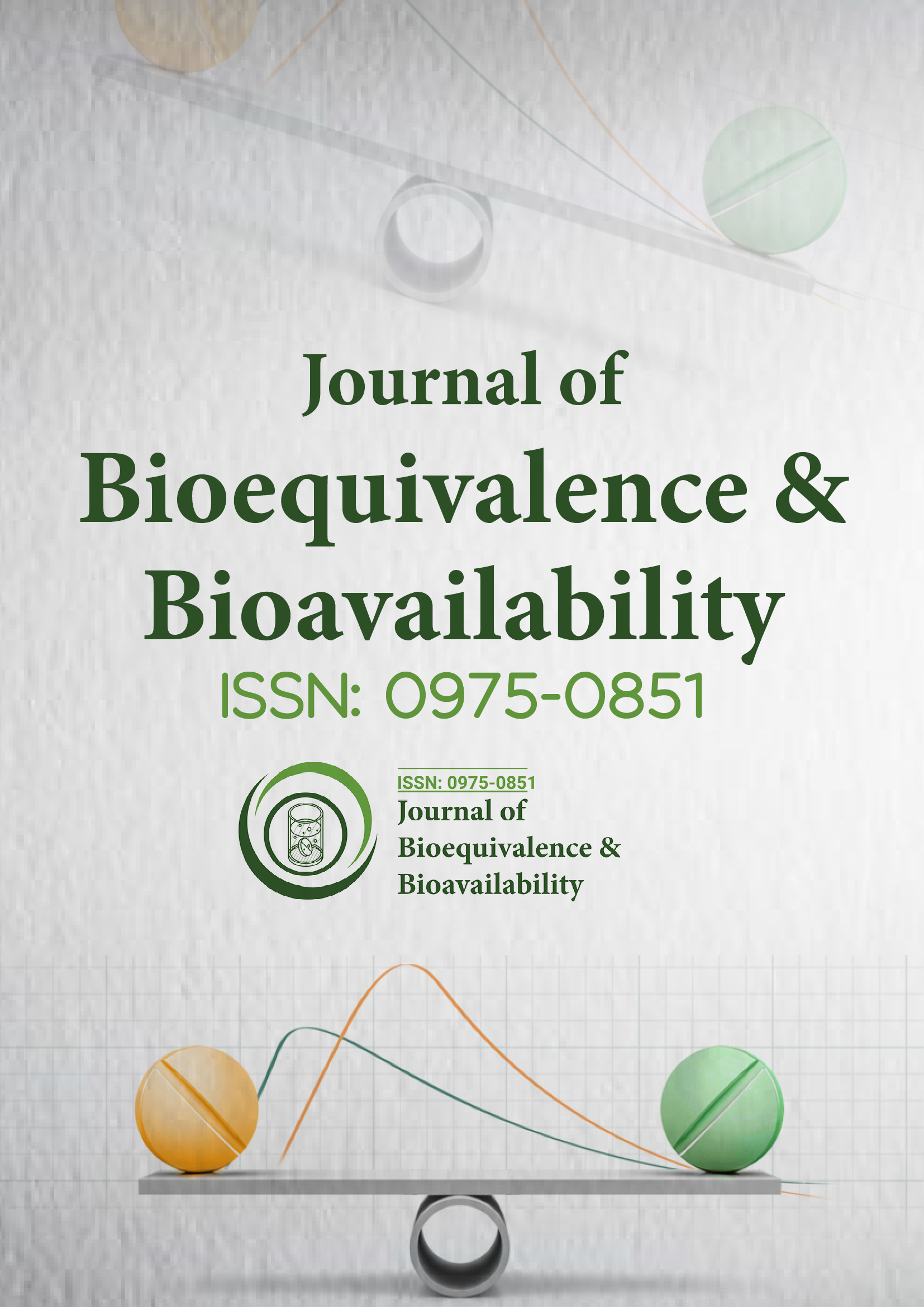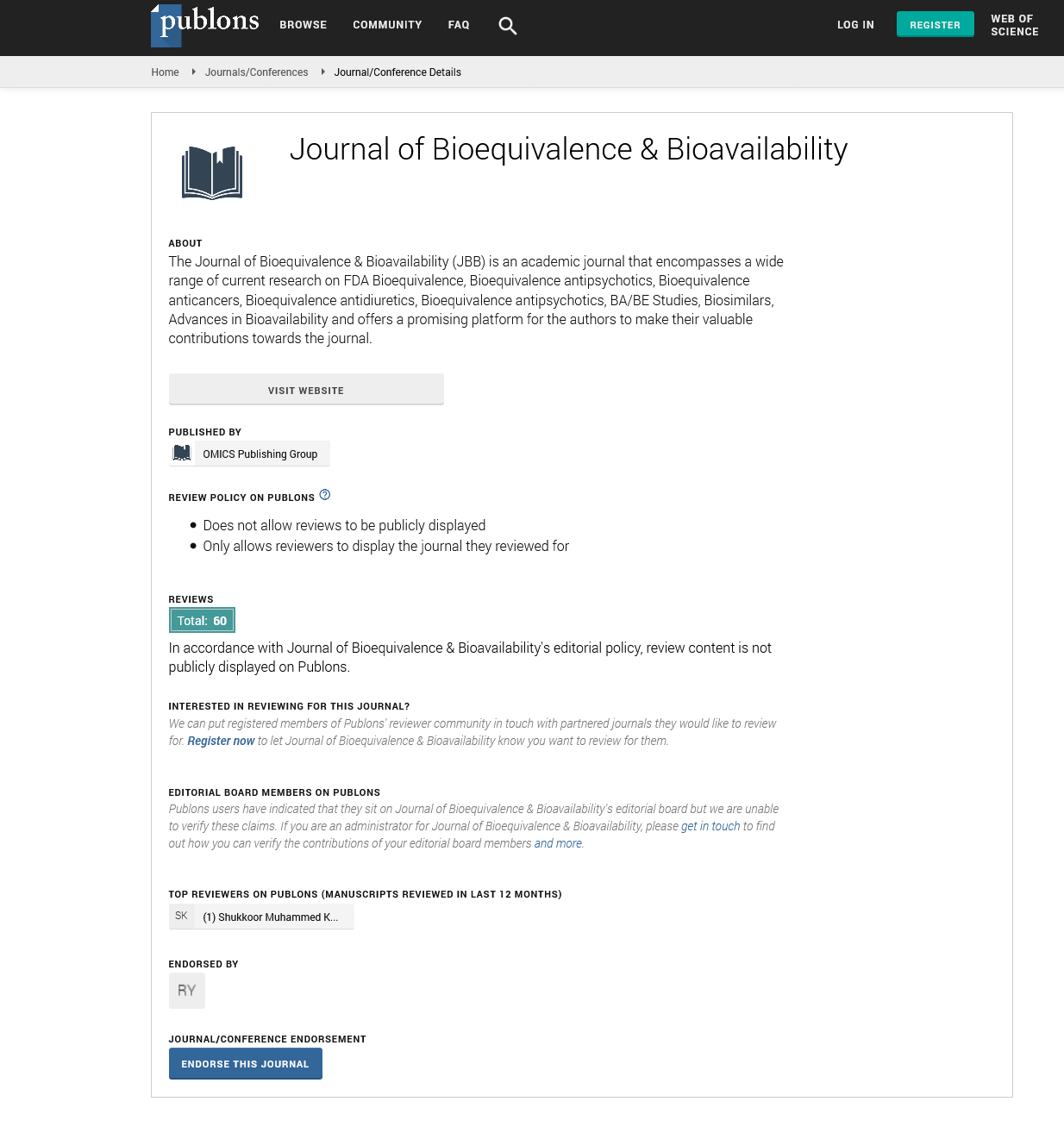Indexed In
- Academic Journals Database
- Open J Gate
- Genamics JournalSeek
- Academic Keys
- JournalTOCs
- China National Knowledge Infrastructure (CNKI)
- CiteFactor
- Scimago
- Ulrich's Periodicals Directory
- Electronic Journals Library
- RefSeek
- Hamdard University
- EBSCO A-Z
- OCLC- WorldCat
- SWB online catalog
- Virtual Library of Biology (vifabio)
- Publons
- MIAR
- University Grants Commission
- Geneva Foundation for Medical Education and Research
- Euro Pub
- Google Scholar
Useful Links
Share This Page
Journal Flyer

Open Access Journals
- Agri and Aquaculture
- Biochemistry
- Bioinformatics & Systems Biology
- Business & Management
- Chemistry
- Clinical Sciences
- Engineering
- Food & Nutrition
- General Science
- Genetics & Molecular Biology
- Immunology & Microbiology
- Medical Sciences
- Neuroscience & Psychology
- Nursing & Health Care
- Pharmaceutical Sciences
Perspective - (2024) Volume 16, Issue 5
Significance of Bioequivalence Testing in the Development of Generic Drugs
Chen Qin*Received: 26-Sep-2024, Manuscript No. JBB-24-27553; Editor assigned: 30-Sep-2024, Pre QC No. JBB-24-27553 (PQ); Reviewed: 14-Oct-2024, QC No. JBB-24-27553; Revised: 21-Oct-2024, Manuscript No. JBB-24-27553 (R); Published: 28-Oct-2024, DOI: 10.35248/0975-0851.24.16.596
Description
Bioequivalence testing is an essential process in the development of generic drugs and biosimilars. This article analyses its significance, methodologies, challenges, and evolving advance- ments. By ensuring therapeutic equivalence between reference and test products, bioequivalence studies has an important role in maintaining public health and promoting accessibility to affordable medications. The pharmaceutical industry continuously strives to develop and provide safe, effective, and affordable medications. This ensures patient safety, therapeutic efficacy, and regulatory compliance, reducing the need for costly and extensive clinical trials.
Bioequivalence studies evaluate whether two pharmaceutical products exhibit similar bioavailability, which is defined as the rate and extent to which the active ingredient or active moiety becomes available at the site of action. Regulatory bodies like the FDA, EMA, and WHO mandate bioequivalence testing as part of the approval process for generic drugs. Bioequivalence refers to the absence of a significant difference in the bioavailability of two pharmaceutical products when administered at the same molar dose under similar experimental conditions.
Importance of bioequivalence testing
Generic drugs provide a more affordable alternative to branded medications, reducing the economic burden on healthcare systems. Bioequivalence testing enables the entry of these costeffective drugs into the market without compromising safety or efficacy. Demonstrating bioequivalence ensures that generic drugs deliver the same therapeutic benefits as the innovator products, fostering trust among healthcare providers and patients. Governments and regulatory agencies rely on bioequivalence data to approve generics, streamlining the drug development process while maintaining stringent safety standards.
Methodologies in bioequivalence testing
Bioequivalence testing primarily relies on pharmacokinetic studies, pharmacodynamic studies, and comparative clinical trials:
Pharmacokinetic (PK) studies: PK studies form the determination of bioequivalence testing and involve the measurement of drug concentrations in biological fluids, typically blood plasma. These studies are conducted in healthy volunteers under controlled conditions. Most PK studies employ a crossover design, where participants receive both the test and reference products in separate periods. This minimizes inter-subject variability. Blood samples are collected at specified time intervals post-dose, and drug concentrations are quantified using techniques like High-Performance Liquid Chromatography (HPLC) or Mass Spectrometry (MS).
Pharmacodynamic (PD) studies: When plasma drug concentration does not correlate well with therapeutic effects (e.g., in locally acting drugs), PD studies are used. These studies measure the drug's effects on biological markers or clinical endpoints. Comparative clinical trials: Comparative trials may be necessary for drugs with complex pharmacokinetics or in cases where PK and PD data alone cannot establish equivalence. These studies are more resource-intensive and are reserved for situations where simpler approaches are insufficient.
Advancements in bioequivalence testing
Technological and methodological innovations are transforming bioequivalence testing, addressing its challenges and improving its efficiency.
Microdosing studies: These studies involve administering subtherapeutic doses of drugs to assess pharmacokinetics without eliciting significant biological effects, reducing ethical concerns.
Modeling and simulation: Physiologically Based Pharmacokinetic (PBPK) models and simulation tools predict drug behavior, potentially reducing the need for extensive in vivo testing.
Biowaivers: Regulatory authorities now grant biowaivers for certain BCS class I and III drugs, allowing bioequivalence to be demonstrated through in vitro studies alone.
Advanced analytical techniques: The use of highly sensitive and specific methods like tandem mass spectrometry enhances the accuracy and reliability of bioequivalence data.
Real-World Evidence (RWE): Incorporating RWE from postmarketing surveillance and electronic health records supplements traditional bioequivalence approaches, particularly for complex drugs.
Conclusion
Bioequivalence testing remains a fundamental pillar of drug development, ensuring the safety, efficacy, and accessibility of generic and biosimilar medications. Despite its challenges, continuous advancements in methodologies, technology, and regulatory science are enhancing its reliability and efficiency. By fostering innovation and global collaboration, bioequivalence testing will continue to play a pivotal role in advancing public health and addressing the ever-growing demand for affordable pharmaceuticals.
Citation: Qin C (2024). Significance of Bioequivalence Testing in the Development of Generic Drugs. J Bioequiv Availab. 16:596.
Copyright: © 2024 Qin C. This is an open-access article distributed under the terms of the Creative Commons Attribution License, which permits unrestricted use, distribution, and reproduction in any medium, provided the original author and source are credited.

